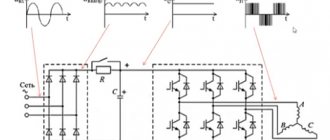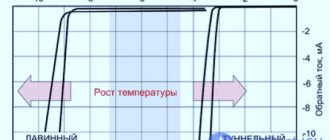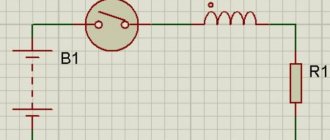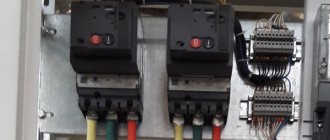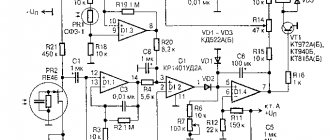An electric convector, like a life preserver, helps cope with low temperatures in our homes during the off-season. The management company has strict regulations for supplying heat to apartment buildings, but the weather has its own, uncoordinated schedule. Solving the problem of discomfort today is not difficult; you just need to go to the nearest store and buy a heater.
Let us make a reservation that the review will not contain an economic comparison of the option of completely replacing the traditional heating system of a house with heating the home using an electric convector. We consider polemics on this issue to be completely inappropriate. Today we are trying to figure out how profitable it is to buy an electric convector, solely in terms of its operation as an additional source of thermal radiation in our apartments.
Electric convector device
It is worth mentioning right away that different models may differ in their design in some blocks, but the main elements remain unchanged. So, all electric heaters consist of:
As can be seen from the figure, the operating principle of an electric convector and its design are quite simple.
- body made of metal;
- heating element (heating element);
- various sensors (temperature, convector position, overheating sensor);
- control panels;
- thermostat;
- gratings.
The body is usually made of light alloy metal. It performs a protective function and is made lightweight specifically to reduce the weight of the product. Two gratings are inserted into it. One of them is located below. Through this hole, cold air is sucked in by the convector. The second is located in front of the heater in its upper part. Already heated air exits through it.
Air can enter the electric heater either naturally (convection, when air rises when heated) or forced. Fans are often installed in devices to increase the air supply, thereby increasing the efficiency of the convector. This operating principle of convector heaters reduces the load on the heat exchanger, which increases the reliability and durability of the device.
The temperature sensor is installed in the lower part of the heater. Typically, it takes a temperature measurement every 45 seconds, after which a signal with the result is sent to the control unit, where the electronic thermostat turns the device on or off (depending on the sensor readings).
Types of heating elements
The heart of the convector is the heating element. Electric models typically use three types of heating elements:
- monolithic;
- tubular with aluminum fins;
- needle.
It is recommended to install models with a monolithic heating element in the bedroom, as they do not make any sounds and will not interfere with rest.
A special feature of a heater with a monolithic heating element is its noiselessness. In this case, the body is made solid (cast). The heat loss of this device is minimal, so it has a high efficiency rate.
In the case of a tubular heating element, the heating element is a steel tube in which a nichrome thread is stretched, and the internal space is filled with insulating backfill (heat-conducting). Fins made of aluminum are fixed to the tube, which provides the device with high heat transfer and increases the degree of convection. Heaters of this type have a long service life and can be installed in the bathroom, but sometimes they make a cracking noise.
Needle heating elements consist of a dielectric thin plate on which a heating chrome-nickel filament coated with insulating varnish is installed. Convectors with such a heating element heat up and cool down almost instantly, but they should not be used in rooms with high humidity levels. The main advantage of devices with needle heating elements is their affordable price, but they cannot be called durable.
Convector electrical circuit
As can be seen from the figure, the circuit of electric heaters of this type is quite simple.
It is enough to connect the device to a 220 V network using a cord, then press the switch button (it completely disconnects the device from the electrical network, so you don’t have to remove the plug, but use the button). The control panel is usually a temperature controller. Also included in the circuit is a safety sensor that opens the circuit when overheated, and a thermostat that turns the convector off or on depending on the ambient temperature.
Operating principle of convector heaters
The principle of operation of a convector type heater
According to the laws of physics, cold air is heavier, so it is located at the bottom. The principle of convection is to pick up cold air masses from below, heat them inside the unit and move them to the top, from where warm air is blown upward. This is how the room is heated. The flow moves continuously, so within 3 - 4 minutes the room becomes warm. Then the air masses cool again and fall down, where they again fall into the lower openings of the convector.
Depending on the model, the device can be transported and turned on, for example, in the country. Electric convection units are more suitable for this.
Devices of this type can be turned on in the bathroom or other rooms with high humidity. This is safe, as they are reliably protected from moisture. The body does not get very hot - if there are small children in the room, they will not get burned if they touch parts of the device.
Modern convectors can be configured to operate in a specific mode. The settings are saved if the power goes out and the device continues to operate.
Additional functionality
Many convector heaters are equipped with additional functions that can be very useful.
One of these functions is the additional equipment of the device with an ionizer.
In addition to heating, such a device will also purify the air, preventing the spread of pathogenic microbes.
An interesting thing is that the ionizer can work even when the convector does not perform its main function - heating.
But a device equipped with an ionizer can accumulate static electricity, so it requires grounding.
Another useful function is the so-called anti-freeze of the device. This function boils down to the fact that when the temperature in the room drops to a critically low level, for example, to +5 C, the device itself will turn on to increase the temperature in the room.
A very convenient function if you plan to be away from home for a long time.
In programmable convectors, a memory function for temperature settings can often be observed.
This function allows you to save all temperature settings and the device will start working with the specified parameters even after temporarily de-energizing it.
And this is only part of the additional functions that a convector heater can be equipped with.
Tips for choosing a convector
When choosing a convector heater, we take into account its following characteristics:
- Power consumption;
- Type of heating element;
- Device dimensions;
- Operational safety;
- Additional features;
- Price;
- Manufacturer;
- Indicators during inspection.
1. So, power. It is selected based on the size of the room to be heated. For example, if you plan to use the device in addition to heating during the period when you are not heating it yet or are no longer heating it, then we calculate the power as follows: for each cubic meter of room volume you need 25 watts of power. But if there is no heating in the house at all, then you will have to calculate based on 40 watts per cubic meter.
Let's give an example: if the area of the room is 19 square meters, the ceilings are 2.7 tenths of a meter, we calculate the power of the heater in the off-season by multiplying these two values by 25. We get 1285.5 watts. We round up and look for a heater with a power of one and a half kilowatts.
2. Type of heating element. As for the heating element, if you have a choice, take a heater with a cast monolithic heater - it will last longer and work more efficiently.
3. Device dimensions
When inspecting the device, pay attention to its dimensions, especially its height. After all, it depends on it how fast the air will move.
For example, low convectors with a height of only 60 centimeters are capable of providing very rapid movement of air masses and, accordingly, heating the room faster
It is also important how heavy the device is - after all, you may have to move it from place to place during use
4. Operational safety. The heater must be as safe as possible. As a matter of fact, convectors are the safest heating devices. After all, their body only heats up to 60 degrees, no more, and therefore will not leave burns. Parents of small children, talking with each other about how to choose convector heaters, give preference to models in which the body has no corners and has smooth contours. Grounding is not necessary for convectors, and they can withstand voltage drops with flying colors.
5. Additional features. Among the additional features that a good convector has, the following can be noted:
- The temperature regulator is a very convenient thing. If it’s warm outside, you can turn it up a little, and if it’s very cold, set it to maximum.
- The thermostat will allow you to constantly maintain the temperature in the room that is most comfortable for you.
- The timer will make it possible to turn on the heater for a certain time, after which the shutdown device will operate. It’s a good idea to use this opportunity in the evening, before going to bed.
- The built-in ionizer absorbs dust, saturating the air with negative ions. It is very good for health. In a room with such a microclimate, you sleep better and work more productively.
- The remote control and on-timer will allow you not to get out from under a warm blanket in the morning to heat the room.
- Rollover protection is a very important feature, especially if you have playful animals or fidgety children in the house.
Mechanical control system.
Convector with electronic control system
6. When looking at the price of the device and deciding which brand of convector to choose, keep in mind that a good thing cannot be cheap. After all, we all want the heater to be efficient and safe, to work for a long time and to have normal warranty service. Therefore, when choosing a device, turn your attention towards well-known brands, whose guarantee is not just empty words. They are truly responsible for the quality of their products, which they have been producing for a long time and successfully selling them on the world market.
Remember these three rules:
Each convector type heater will dry the air in the room. There is simply no other option, according to the operating principle. The maximum that can help: a container of water for evaporation.
Since air is constantly moving through the process of convection, dust will move along with it. Over time, it will accumulate between the plates. If a deceitful seller tells you that “only this model” of the convector does not accumulate dust, do not listen to these tales and call another consultant.
Any electric heater has an efficiency factor close to 100 percent. Therefore, do not believe that only this model, stubbornly imposed by the seller, can provide such efficiency.
Frame
When choosing a convector, you should also pay attention to the housing.
Firstly, you need to take into account the height of the device; the speed of air movement inside the housing depends on it, which ultimately affects the efficiency of its operation.
A convector with a height of 50 cm is considered optimal. This criterion also applies to floor convectors, but it is not its height that is taken into account, but its width.
Secondly, you need to take into account the thickness of the walls of the housing, because its walls also participate in heat exchange. Therefore, the thicker the walls of the housing, the higher the heat transfer will be, which means the efficiency of the device itself will be higher.
Tips for use
Proper operation will extend the life of the convector and make its operation as safe as possible. In general, convection equipment does not require special conditions, but basic rules should still be followed.
- Periodically, dust must be removed from the body of the device when it is turned off.
- When installing, make sure that the lower part of the convector rises above the floor by at least 15 cm, and is 25 cm from the wall.
- Do not cover the convector with any objects on top, hang laundry or place it in a niche that is too low. There should be a distance of about half a meter at the top, otherwise the convector will overheat. This will lead to damage (unless the device is equipped with a special overheating sensor).
- If there are children in the house, try to choose a stationary type convector model without wheels.
The following video provides a detailed overview of trench convectors.
Safety
An important factor when choosing a convector is the safety of its operation.
And although such devices are not capable of causing a burn to a person, since the body does not heat up to a traumatic temperature, there is, however, the possibility of accidentally tipping it over.
This is especially true for free-standing convectors.
To eliminate the possibility of a fire from a short circuit if accidentally tipped over, you should purchase devices equipped with a tip-over sensor.
This sensor, if the device overturns, will instantly de-energize it.
You should also take into account the weak level of electrical protection of devices with needle-type heating elements.
Pros and cons of using it at home
A convector heater does not require special permission for operation.
There are many positive aspects that make it worth buying a convector for a house or apartment:
- There is no need to obtain permits for operation if it is an ordinary electrical device.
- Easy to install. The convector on legs is installed in the right place and plugged into an outlet. There are wheels for moving.
- Adjustable temperature. Some models have built-in sensors that support the desired operating mode.
- Silent - can be turned on around the clock.
- Compact dimensions allow convectors to be installed in small spaces.
- They do not burn oxygen, since the temperature inside the heating element does not exceed 65 degrees.
- Economical. They are cheaper than oil radiators, but the efficiency is much higher. When no one is home, the heater can be set to a lower temperature.
- The low cost allows you to install several devices in one room, if necessary.
- The devices are fireproof and have overheating protection.
- You can purchase a convector heater with a protective screen with adjustable air flow directed to a specific area.
This type of heating has few disadvantages. Higher power devices will require more electricity. The inconvenience may be associated with the installation of in-floor convectors, the grille of which is at the same level with the coating - debris will fall inside the unit. If the room is dusty, dust particles will constantly float in the air due to circulation. The apartment will have to be wet cleaned more often.
Heater with remote control
Additional equipment can be connected to this type of device:
- humidifier;
- timer;
- thermostat for precise temperature control;
- remote control to turn on devices remotely.
Additional equipment is usually not included with the device. If necessary, it can be purchased separately.
Installation of equipment
Installation of a floor heating convector must be carried out strictly according to the recommendations described in the attached operating instructions, especially when installing an option built into the floor. We begin the installation work with careful markings, the algorithm of all actions is clearly shown in this video
https://youtube.com/watch?v=PbXkRkZAax0
Pipe laying
When installing the system in a house under construction, all work is completed before finishing work and pouring the floors. The convector is connected to the water supply using metal braided hoses or non-ferrous metal pipes, but it is better to make a separate connection from the central heating.
When replacing a central heating radiator with a floor convector, we make the connection according to a previously installed and current scheme.
Level check
It is very important to install the product strictly horizontally - for this there are adjusting bolts on it. This rule applies to all convectors - located on the floor or built into it
After installation and performance testing, the final filling and leveling of the floor begins: the edge of the product body should not protrude above the floor level. The last thing, after the floor has completely dried, is the decorative grille.
Varieties
Convectors have many varieties, which differ:
- by type of coolant (electric, gas, water);
- by type of operation (convection, infrared or mixed type);
- by installation method (floor, wall, ceiling, baseboard);
- by material of manufacture (steel, ceramic, glass, quartz);
- according to additional options (with natural convection or forced with a fan, with an ionizer or humidifier, with a dust filter and others).
When choosing a convector for your dacha or home, you should also remember about the different power of the devices. Preference should be given to one type or another based on the volume of heated air in the room. Manufacturers usually indicate the maximum number of square meters for which the device is designed.
If, for example, the room is poorly insulated, there are drafts, the windows face north, or there are other conditions that contribute to a decrease in temperature and heat loss, you should choose a convector of higher power. So, for a room of 15-20 square meters, purchase a heating device with a power of at least 2 kW. A 1 kW device can heat a very small room of up to 12 square meters. If the convector has additional options (air humidification, electronic thermoregulation), then it is worth taking into account these losses when operating the device. Accordingly, it will fit an area smaller than the declared one by about 30-40%.
Infrared
These are the most modern innovative models. Their effectiveness is increased due to the additional effect of infrared radiation. Combined type devices have 2 heating elements and can operate even if one of them fails.
They have increased efficiency and warm up the room faster than other types due to the transfer of heat by IR waves to surrounding objects. Such devices often have decorative panels and are the latest generation heating systems.
Electrical
Electric convectors work by heating the internal element (heating element) with electric current. Using such a device is absolutely safe. The heating element is protected by the insulation and shell of the convector, so at any set temperature its surface does not heat up above 50-60 degrees.
They are equipped with automatic thermostats. It is worth remembering that an electric convector consumes a sufficient amount of energy. Therefore, you need to choose the option with maximum energy saving. It is suitable for a small room or intermittent operation (between heating seasons).
Gas
The gas convector is not very popular, although it was originally designed as a more economical alternative to the electric one. It runs on liquefied gas from a cylinder. It is also convenient to use it in private households if it is possible to connect to the highway. At the same time, its installation should be carefully considered, since further dismantling and transfer of the device may cause difficulties.
In addition, a gas convector requires a flue gas removal and recovery system. Installing such a convector will require special skills. And the savings become relative, since significant heat losses will occur through ventilation to remove gases in the outer wall.
Mermen
Convectors with water as a coolant are characterized by maximum efficiency, ease of use and safety.
Water intake for heating comes from the centralized heating system. They are compact and can be hidden under the floor surface (so-called “plinth models”). Their only drawback is the small area of the heated room. It should not exceed 10-12 square meters.
Heat sources
To heat a living space, a person uses different heat sources. The most common was hot water circulating in a closed kennel from pipes laid throughout the house.
But the water still needs to be heated before being fed into the pipes. For this purpose, centralized heat supply is used in multi-storey buildings.
In this case, there is a separate boiler plant, where combustion of gas or coal is used for heating.
In private homes, autonomous gas heating is more often used, where a small gas boiler is used to heat water, providing heat only to the house in which it is installed.
It’s just that with centralized heating, certain deadlines are set for providing heat to the house, and the heat supply itself wants to leave the best.
In the private sector, there are times when the house is cool and you don’t want to start the boiler.
In this case, electric heaters come to the rescue. Although they consume a significant amount of electricity, since they have significant power, they are able to quickly heat any room in the house.
There are a large number of types of electric heaters, from simple spiral heaters, popularly nicknamed “goats,” to modern infrared and convector heaters.
The latter are becoming increasingly popular these days.
How does it work
Note! The operating principle of the described device is based on the phenomenon of convection. From the physics course we know that cold air is heavier than warm air, it is located in the lower part of the room, heated air masses gradually rise upward
Due to such movements, the entire air space in the room is heated.
The convector operates according to a simple algorithm. At the bottom of this device there is a heating element (it is also called a heat exchanger). To increase the volume of air passed through, this part is made in the form of a radiator with several flat fins. The angle of their inclination regulates the direction of heated air flows. The heat exchanger is covered by a protective metal casing.
According to the energy carrier used, all convectors can be divided into the following types:
- Devices powered by electricity;
- Gas convectors;
- Mermen.
Convector heater device
At the top, as well as at the bottom of the convector body, there are several holes for sucking in cold air and transporting heated air. Structurally, it is made in such a way that the body of our device does not have direct contact with the heat sink, so the casing does not heat up and does not transfer heat. A similar transfer of heat resources occurs in water and oil radiators.
In everyday life, electric type convectors are mainly used. Water appliances have lower efficiency indicators; they differ from analogues in their significant overall dimensions, so they are installed in places where traditional water radiators are installed in niches under windows. Gas equipment, despite the possibility of saving energy resources, for some reason is not popular among consumers.
All models of the heaters under consideration, regardless of type, may have different overall dimensions. Some of them are equipped with built-in sensors and many additional functions. The main advantages of convectors are:
- Quiet operation. This characteristic is due to the absence of a fan in the device that hums;
- Possibility of installing the device on various surfaces (on the floor or wall, there are models that can even be installed on a windowsill);
- Beautiful design that will allow the installation to “fit” into any interior;
- Low heating temperature of the case, on average 60 degrees, maximum parameters - 90 degrees;
- Large models have wheels for easy movement around the room; lightweight devices can be mounted on the wall;
- When heating a room with a convector, oxygen is not burned;
- Devices can be left unattended;
- Long-term operation. Many manufacturers provide a 10-year warranty on the product.
Operating principle of the convector
Despite the huge number of advantages, convectors also have negative qualities. The disadvantages of such devices include:
- Low noise level when warming up;
- Impossibility of replacing the heating element at home;
- The absence of a fan affects the rate at which the room warms up.
Note! The movement of well-heated dry air in a room affects the well-being of allergy and asthma sufferers. The ideal option for such people would be a convection air conditioner equipped with a humidifier.
Convection heaters
Now we will answer the question of what a convector type heater is. A convector is a device that uses convection, in most cases natural, in its operation. The basis of the design of each device is:
- Housing - it is designed to protect people from accidental contact with live or hot parts. It also plays a decorative role. The body contains controls, indicators and information screens;
- Heating element – in convection heaters it can be electric, gas or water. It is he who is responsible for heating the air in the rooms;
- Thermostat - it can have a very different design.
All convection heaters are extremely simple, there is nothing complicated or supernatural about them. Thanks to this, they have earned such popularity.
The convector design is distinguished by its simplicity, and this is a sure sign of reliability.
They work very simply - when you turn on the gas, supply hot coolant or electricity, the ribbed heating element heats up, which begins to warm up the air. Air masses become lighter as they travel upward. This process is closely monitored by automation that regulates heating. At the same time, cold air enters the convectors, which envelops the heating element - the cycle repeats.
As soon as the air temperature sensor sees that the heating level has reached the specified limit, it will give a command to turn off the heating element. As soon as the air cools below the set norm, the thermostat will work and give a command to activate the device. Thus, convectors ensure the maintenance of stable air temperature in the premises.
In water convectors, temperature control is carried out using a special thermostatic valve-regulator.
Types of convectors
Depending on what coolant is supplied to the heating system, you can choose a water or gas convector. The internal structure of the devices will be slightly different, but the principle is the same: the coolant heats the elements inside the device, through which air passes and picks up heat, then leaves the heater and warms the room.
Gas
Gas convector heater
Inside the convector there is a burner that heats the gas. The device has an air intake, one end of which is located outside. Oxygen is needed to support combustion. A chimney is needed to remove combustion products from the combustion chamber.
Gas convector heating at home does not require water, it is safe, since the combustion chamber is completely insulated.
The disadvantages of gas appliances are as follows:
- To install a convector, you need to obtain permission from the gas industry. The problem may arise due to the design of the house and the impossibility of installing a chimney.
- When heated with gas, the body temperature is above 60 degrees, so the process of thermal decomposition of dust particles begins, which settle on furniture and other interior items.
Mermen
Water heating convector
Water convectors can be installed in autonomous and central heating systems. They are reliable and durable, and are also capable of transferring up to 95% of the generated heat.
According to the type of installation, water heaters can be in-floor, baseboard, wall, floor, or basement. They are connected to pipes of any diameter through a series of adapters. The case temperature usually does not exceed 30 degrees, so small children cannot get burned by touching the device.
Water heating convectors built into the floor are planned at the stage of building a house, as niches are built under them and pipes are supplied. Once the floor is poured, it will be impossible to install such models.
Wall-mounted water heating convectors are usually placed under windows to reduce the flow of cold air if the double-glazed window is single-chamber.
If you need to hide the heating system, you can buy built-in models. They are mounted in special niches in the wall or mounted on furniture.
Among the advantages:
- Light weight, which allows you to install devices on plasterboard partitions.
- Compact due to slim body.
- You can customize and regulate the temperature.
- There are models with one or two heat exchangers.
Electrical
Electric floor convector heater
Electric convectors are considered the safest. Most manufacturers produce devices with the highest degree of electrical protection: not a single wire comes into contact with the housing. Thanks to this, the models can be operated without grounding.
The water heating temperatures are low enough so that oxygen does not burn and dust does not break down into microparticles that have a bad effect on the state of the human respiratory system. Low heating temperatures are compensated by the volume of heating elements.
Any heater consumes fuel. In this case, it is electricity, for which you do not need to go or travel far, such as for firewood or gasoline. Electricity consumption can be high if the premises are rather large in size or if the temperature in the winter season drops significantly below zero degrees. To save money, it is advisable to install double-glazed windows with argon coating, which prevents heat from escaping.
Infrared
Convection Infrared Heater
If a typical convector heats air by circulating it through a heat exchanger, then the principle of infrared heating of a house with convectors is different. The device heats surrounding objects using infrared radiation, and the objects give off heat to the surrounding space. In this regard, it is desirable that the device be installed in a place where its radiation on objects or walls will be maximum. Then the heat transfer will be high.
It is better to use infrared heaters as an additional source of heat, since when turned off, the room quickly cools down.
There are only two models of heaters in the infrared series - floor and wall. They require a working outlet with high-quality wiring. It is not advisable to use extension cords if the appliance will be operating at full power.
heating elements
Next you should pay attention to the heating elements. Needle-type heating elements, where the spiral is not protected by anything and is fixed on a thin plate, are very fragile; a small blow to the body is enough for the spiral thread to break.
But such convectors are much cheaper than with other types of heaters.
The most reliable and durable are monolithic heating elements. They are not afraid of shocks and can even withstand the device being tipped over. However, the cost of devices with heating elements is much higher.
The choice of monolithic heating elements is also supported by the operation of the convector itself.
Needle-type heaters may crackle slightly during operation, while monolithic heaters are absolutely silent.

